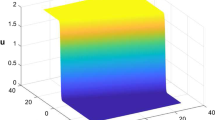Abstract
Based on Bell polynomials approach, in this paper we have used Maple computer algebra package PDEBellII for constructing bilinear equations for some nonlinear evolution equations. Bilinear equations are then used to construct exact solutions using novel test function. Symbolic manipulation program Maple has been used to carry out tedious calculations involved, and a simple Maple code is also given in the form of appendix. The exact solutions obtained using novel test function enrich the solution structure of well-known evolution equations.







Similar content being viewed by others
References
Malfliet, W.: Solitary wave solutions of nonlinear wave equations. Am. J. Phys. 60(7), 650–654 (1992)
Malfliet, W., Hereman, W.: The tanh method: I. Exact solutions of nonlinear evolution and wave equations. Phys. Scr. 54(6), 563–568 (1996)
Liu, S., Fu, Z., Liu, S., Zhao, Q.: Jacobi elliptic function expansion method and periodic wave solutions of nonlinear wave equations. Phys. Lett. A 289(1–2), 69–74 (2001)
Zhou, Y., Wang, M., Wang, Y.: Periodic wave solutions to a coupled KdV equations with variable coefficients. Phys. Lett. A 308(1), 31–36 (2003)
He, J.H., Wu, X.H.: Exp-function method for nonlinear wave equations. Chaos Solitons Fractals 30(3), 700–708 (2006)
Bekir, A.: Multisoliton solutions to Cahn–Allen equation using double exp-function method. Phys. Wave Phenom. 20(2), 118–121 (2012)
Kaplan, M., Bekir, A., Akbulut, A.: A generalized Kudryashov method to some nonlinear evolution equations in mathematical physics. Nonlinear Dyn. (2016). doi:10.1007/s11071-016-2867-1
Çevikel, A.C., Bekir, A., Akar, M., San, S.: A procedure to construct exact solutions of nonlinear evolution equations. Pramana 79(3), 337–344 (2012)
Bluman, G.W., Anco, S.C.: Symmetry and Integration Methods for Differential Equations, vol. 154. Springer, New York (2002)
Gupta, R.K., Singh, K.: Symmetry analysis and some exact solutions of cylindrically symmetric null fields in general relativity. Commun. Nonlinear Sci. Numer. Simul. 16(11), 4189–4196 (2011)
Ablowitz, M.J., Clarkson, P.A.: Solitons, Nonlinear Evolution Equation and Inverse Scattering. Cambridge University Press, Cambridge (1999)
Hirota, R.: Direct method of finding exact solutions of nonlinear evolution equations. In: Bullough, R., Caudrey, P. (eds.) Bäcklund Transformations, vol. 515, pp. 40–68. Springer, Berlin (1976)
Singh, M.: New exact solutions for (3+ 1)-dimensional Jimbo–Miwa equation. Nonlinear Dyn. 84(2), 875–880 (2016)
Miao, Q., Wang, Y., Chen, Y., Yang, Y.: PDEBellII: A Maple package for finding bilinear forms, bilinear Bäcklund transformations, Lax pairs and conservation laws of the KdV-type equations. Comput. Phys. Commun. 185(1), 357–367 (2014)
Gilson, C., Lambert, F., Nimmo, J., Willox, R.: On the combinatorics of the Hirota D-operators. In: Proceedings of the Royal Society of London A: Mathematical, Physical and Engineering Sciences, vol. 452, pp. 223–234. The Royal Society (1996)
Bell, E.T.: Exponential polynomials. Ann. Math. 35(2), 258–277 (1934)
Singh, M., Gupta, R.K.: Bäcklund transformations, Lax system, conservation laws and multisoliton solutions for Jimbo-Miwa equation with Bell-polynomials. Commun. Nonlinear Sci. Numer. Simul. 37, 362–373 (2016)
Hirota, R.: The Direct Method in Soliton Theory. Cambridge University Press, Cambridge (2004)
Date, E., Jimbo, M., Kashiwara, M., Miwa, T.: KP hierarchies of orthogonal and symplectic type-Transformation groups for soliton equations VI-. J. Phys. Soc. Jpn. 50(11), 3813–3818 (1981)
Jimbo, M., Kashiwara, M., Miwa, T., et al.: Transformation groups for soliton equations IV. A new hierarchy of soliton equations of KP-type. Phys. D Nonlinear Phenom. 4, 343–365 (1982)
Ma, W.-X., Fan, E.: Linear superposition principle applying to Hirota bilinear equations. Comput. Math. Appl. 61(4), 950–959 (2011)
Ma, W.-X., Zhu, Z.: Solving the (3+ 1)-dimensional generalized KP and BKP equations by the multiple exp-function algorithm. Appl. Math. Comput. 218(24), 11871–11879 (2012)
Na, L.: Bäcklund transformation and multi-soliton solutions for the (3+ 1)-dimensional BKP equation with Bell polynomials and symbolic computation. Nonlinear Dyn. 82(1–2), 311–318 (2015)
Ma, W.X., Abdeljabbar, A.: A bilinear Bäcklund transformation of a (3+ 1)-dimensional generalized KP equation. Appl. Math. Lett. 25(10), 1500–1504 (2012)
Wazwaz, A.-M.: Multiple-soliton solutions for a (3+ 1)-dimensional generalized KP equation. Commun. Nonlinear Sci. Numer. Simul. 17(2), 491–495 (2012)
Zhang, S., Xia, T.C.: A further improved extended Fan sub-equation method and its application to the (3+ 1)-dimensional Kadomstev-Petviashvili equation. Phys. Lett. A 356(2), 119–123 (2006)
Tian, B., Gao, Y.-T.: Beyond travelling waves: a new algorithm for solving nonlinear evolution equations. Comput. Phys. Commun. 95(2), 139–142 (1996)
Ya-Ning, T., Wen-Xiu, M., Wei, X.: Grammian and Pfaffian solutions as well as Pfaffianization for a (3+ 1)-dimensional generalized shallow water equation. Chin. Phys. B 21(7), 70212–70218 (2012)
Ma, S.-H., Fang, J.-P., Hong-Yu, W.: Elastic and annihilation solitons of the (3+ 1)-dimensional generalized shallow water wave system. Zeitschrift für Naturforschung A 68(5), 350–354 (2013)
Ma, W.-X.: Complexiton solutions to integrable equations. Nonlinear Anal. Theory Methods Appl. 63(5), e2461–e2471 (2005)
Author information
Authors and Affiliations
Corresponding author
Appendix
Appendix
Maple program for computing coefficients in algebraic expression
Step 1
#Define Hirota derivative;
Step 2
#Define new test function;
Step 3
#Substitution of new test function into bilinear equation (23) (for example sake);
#This command will generate large expression in coefficients of \(e^{\pm \xi _{1}}, e^{\pm \xi _{1}}\tan (\xi _{2})\), \(e^{\pm \xi _{1}}\tanh (\xi _{3}), \tan (\xi _{2})\tanh (\xi _{3})\)
Step 4
#Sorting terms in large expression in previous step;
#This command will sort all terms of expression in appropriate order
Step 5
#Collecting coefficients from expression sorted in previous step
#This command will produce list of all coefficients in expression.
Step 6
#Solving algebraic equations
#This command will generate set of solutions for \(a_{i}, b_{i}, c_{i}, d_{i}, \delta _{i}\)
Rights and permissions
About this article
Cite this article
Singh, M., Gupta, R.K. Exact solutions for nonlinear evolution equations using novel test function. Nonlinear Dyn 86, 1171–1182 (2016). https://doi.org/10.1007/s11071-016-2955-2
Received:
Accepted:
Published:
Issue Date:
DOI: https://doi.org/10.1007/s11071-016-2955-2



